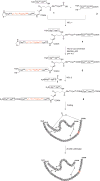Efficient Total Chemical Synthesis of (13) C=(18) O Isotopomers of Human Insulin for Isotope-Edited FTIR
- PMID: 26715336
- PMCID: PMC5477233
- DOI: 10.1002/cbic.201500601
Efficient Total Chemical Synthesis of (13) C=(18) O Isotopomers of Human Insulin for Isotope-Edited FTIR
Abstract
Isotope-edited two-dimensional Fourier transform infrared spectroscopy (2 D FTIR) can potentially provide a unique probe of protein structure and dynamics. However, general methods for the site-specific incorporation of stable (13) C=(18) O labels into the polypeptide backbone of the protein molecule have not yet been established. Here we describe, as a prototype for the incorporation of specific arrays of isotope labels, the total chemical synthesis-via a key ester insulin intermediate-of 97 % enriched [(1-(13) C=(18) O)Phe(B24) ] human insulin: stable-isotope labeled at a single backbone amide carbonyl. The amino acid sequence as well as the positions of the disulfide bonds and the correctly folded structure were unambiguously confirmed by the X-ray crystal structure of the synthetic protein molecule. In vitro assays of the isotope labeled [(1-(13) C=(18) O)Phe(B24) ] human insulin showed that it had full insulin receptor binding activity. Linear and 2 D IR spectra revealed a distinct red-shifted amide I carbonyl band peak at 1595 cm(-1) resulting from the (1-(13) C=(18) O)Phe(B24) backbone label. This work illustrates the utility of chemical synthesis to enable the application of advanced physical methods for the elucidation of the molecular basis of protein function.
Keywords: IR spectroscopy; chemical protein synthesis; human insulin; isotopic labeling; native chemical ligation.
© 2016 WILEY-VCH Verlag GmbH & Co. KGaA, Weinheim.
Figures








References
-
- Baiz CR, Reppert M, Tokmakoff A. Ultrafast Infrared Vibrational Spectroscopy. CRC Press; 2013. pp. 361–404.
Publication types
MeSH terms
Substances
Grants and funding
LinkOut - more resources
Full Text Sources
Other Literature Sources
Medical
Molecular Biology Databases

